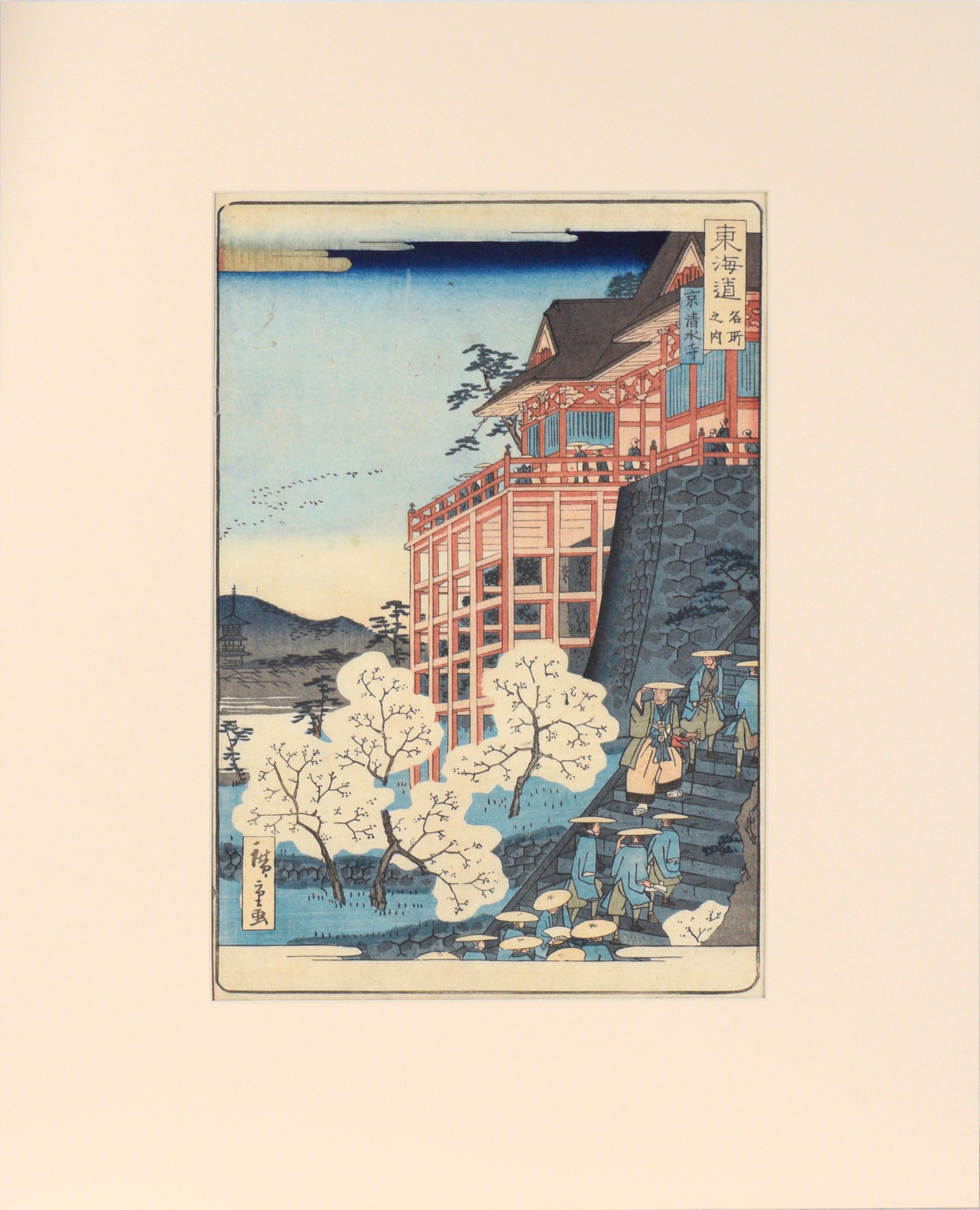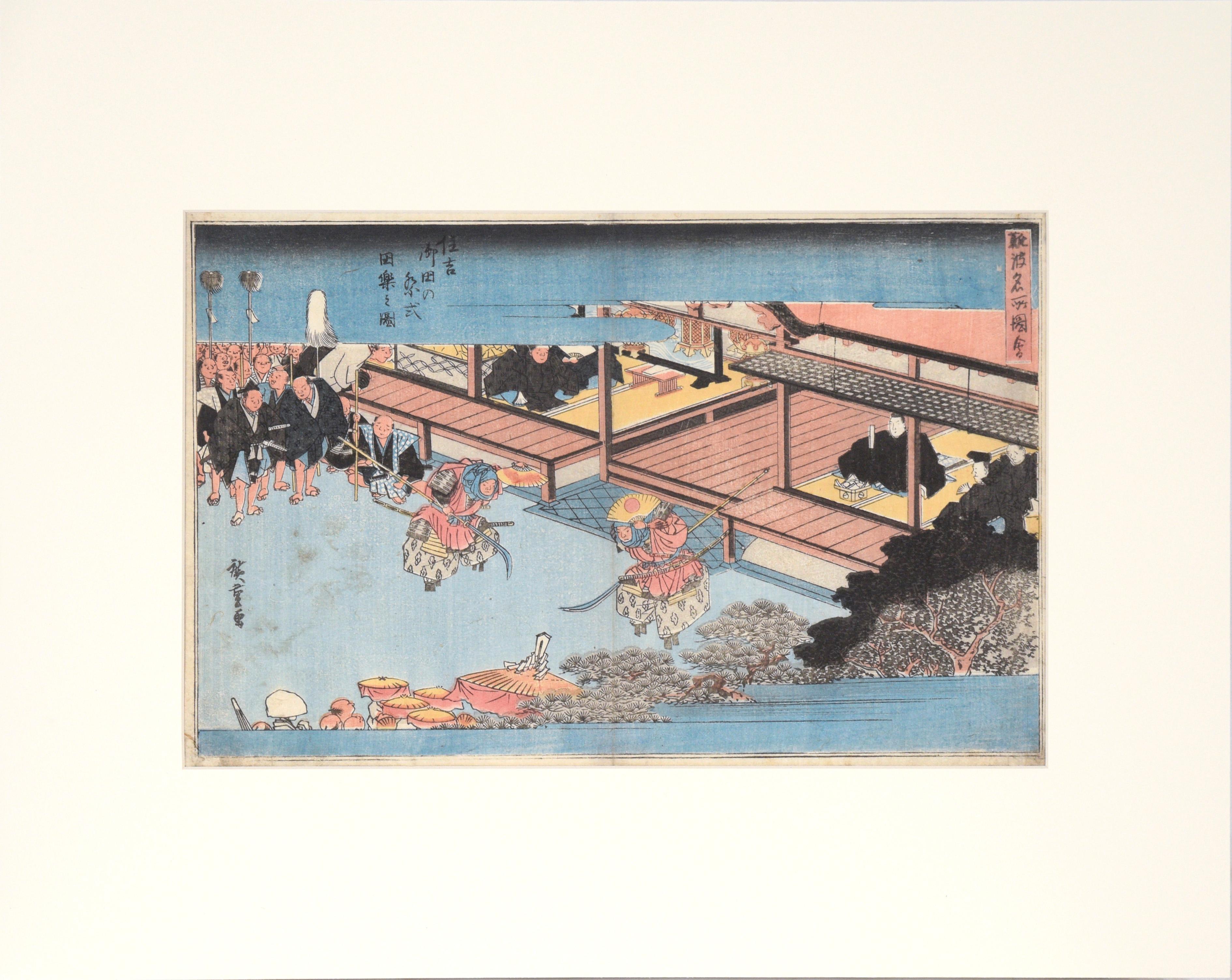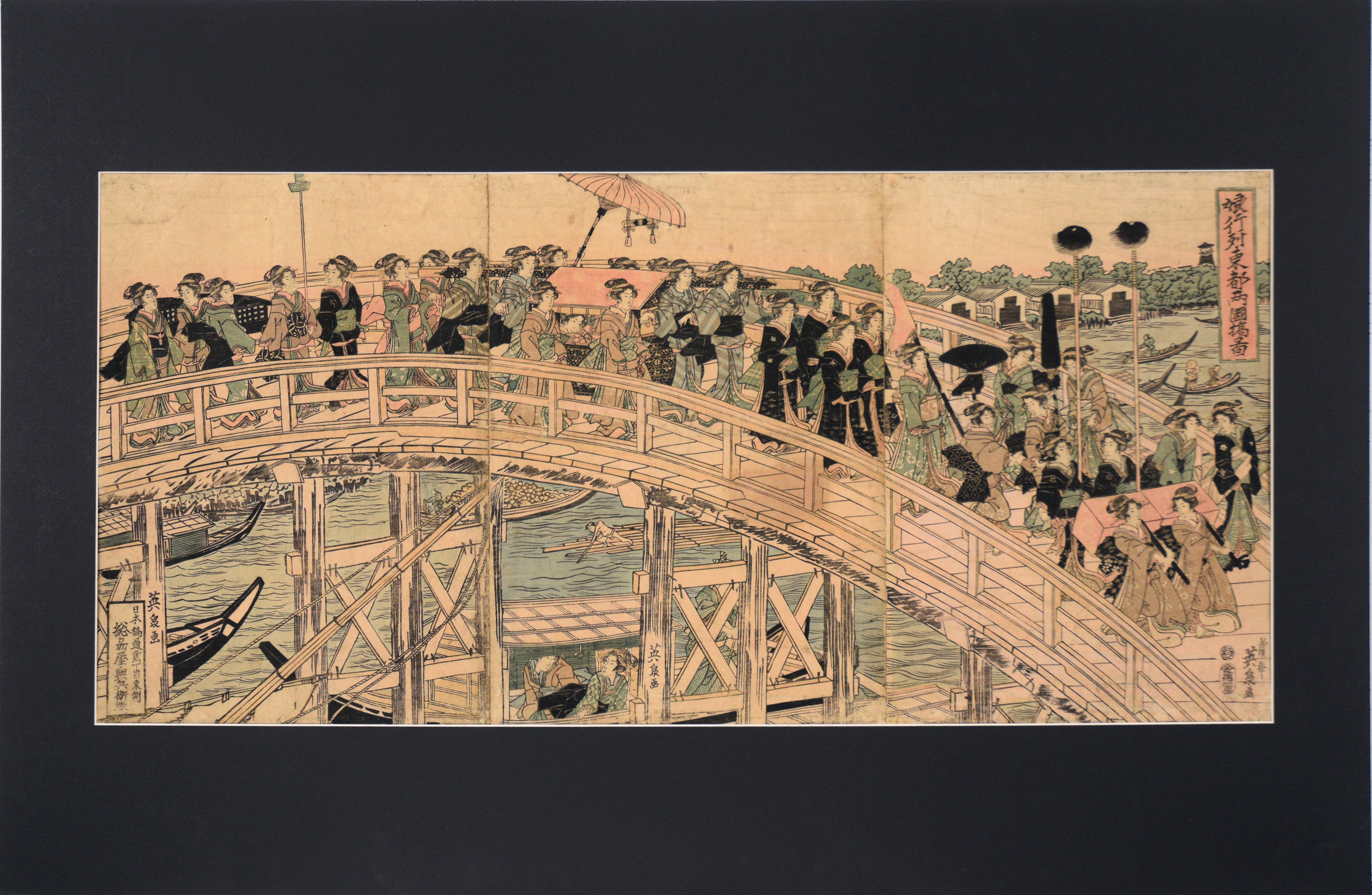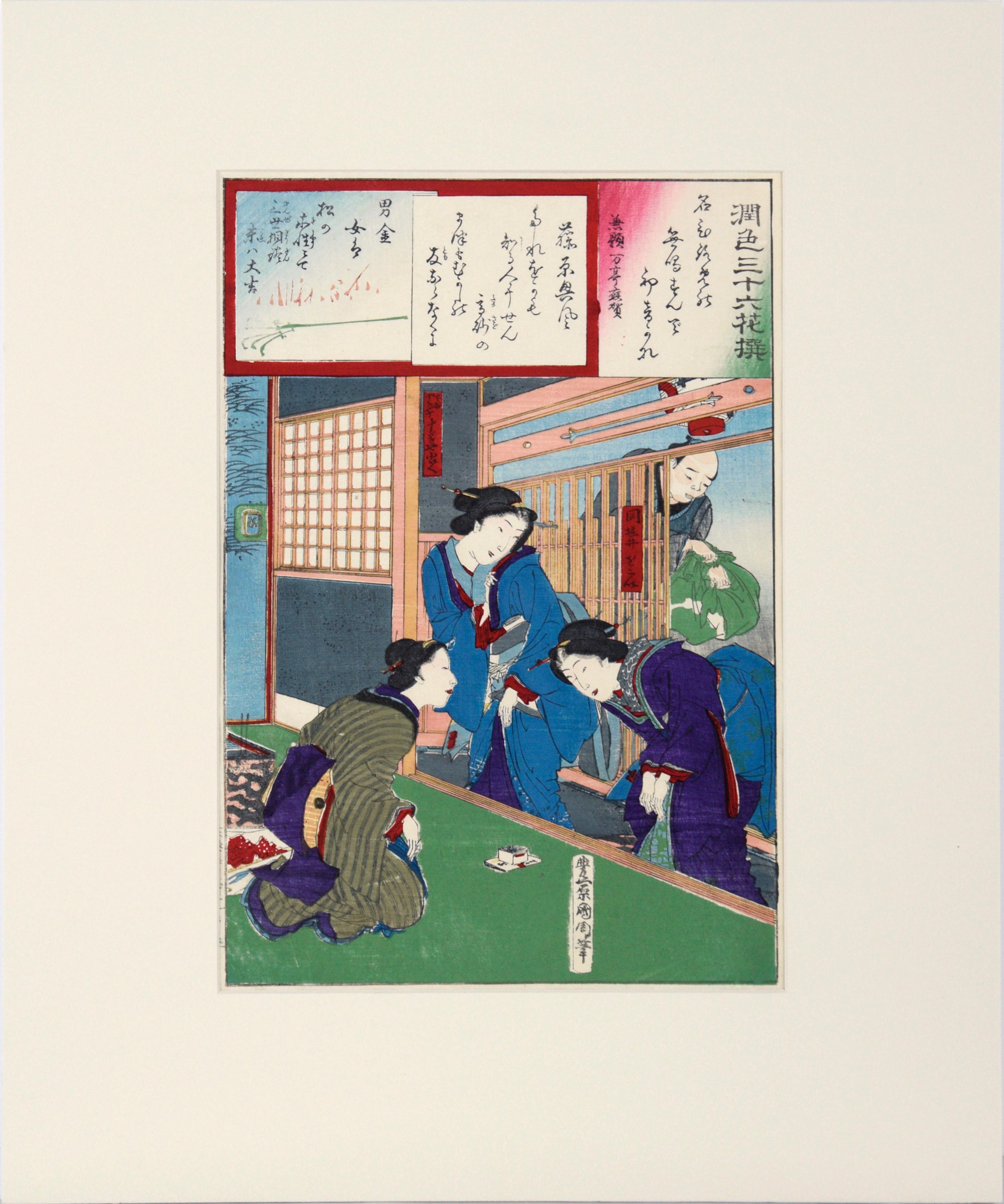Items Similar to Narihira's Journey to the East - Japanese Woodblock on Paper by Kikugawa Eizan
Want more images or videos?
Request additional images or videos from the seller
1 of 15
Kikugawa EizanNarihira's Journey to the East - Japanese Woodblock on Paper by Kikugawa Eizan19th C
19th C
About the Item
Narihira's Journey to the East - Japanese Woodblock on Paper
Original 19th century Japanese woodcut print depicting Narihira's journey to the East by a follower of Utamaru,
Kikugawa Eizan (Japan, 1787-1867). It is rare to find a complete triptych in good condition as this one. Below Mt Fujiyama the procession travels on their journey. Narihira himself, was represented as a pretty girl showing off her fine clothes.
Eizan Kikukawa “Todai Azuma Kudari”
Horse Museum Collection
菊川英山「当世吾妻下り」
馬の博物館所蔵
Kikukawa eizan `tōsei Adzuma kudari'-ba no hakubutsukan shozō
Presented in a black mat.
Mat: 24"H x 36"W
Image: 14.5"H x 29.5"W
Kikugawa Eizan, born in 1787 as Toshinobu Omiya, passed away in 1867. While not a direct pupil of Kitagawa Utamaro, he began his artistic journey under the tutelage of his father, Kikugawa Eiji, a Kano style painter and fan maker. Later, Eizan further honed his skills studying with Shijo artist Suzuki Nanrei and the Hokusai pupil Hokkei Totoya.
Kikugawa Eizan Biography:
Although Kikugawa Eizan appears to have retired from printmaking in the late 1820s, he continued contributing illustrations for books, even in the latter years of his life. His passing occurred in 1867.
Often categorized alongside Kikumaro, Tsukimaro, and Utamaro II, Eizan has faced criticism from connoisseurs who label him as a plagiarist of Utamaro's late style. However, Eizan's body of work showcases a developmental journey typical of ukiyo-e artists, transitioning from a close association with a master to achieving studied independence. His portfolio includes pieces of remarkable beauty and interest.
Bijin-ga in the Footsteps of Utamaro
In the subsequent decade, as Eizan reached artistic maturity, he embarked on the development of his distinctive figural style, primarily centered around prints featuring beautiful women (bijin-ga). While Eizan's work maintains the sensitivities and lyricism reminiscent of the Utamaro style, it diverges from the earthier realism and more overt sensuality seen in the bijin prints of Kunisada and Ikeda Eisen.
The ninth chapter in The Tales of Ise is the most famous passage of the text and one of the most frequently illustrated in Japanese literature. Narihira has lost all will to continue his worldly life in the capital and, in a disconsolate mood, leaves home with one or two close friends in search of a peaceful existence in the eastern provinces. Illustrators most often represented the moment during this Azuma kudari, or journey to the east, when the dispirited travelers pass the foot of Mount Fuji. Supposedly, that is the subject of the triptych here, but the artist had no qualms whatsoever about abandoning the loneliness and disillusionment of the journey described in The Tales of Ise. In this mitate, or contemporary parody of classical subjects, the poetic description of the small, gloomy group of travelers is used as an excuse to mount a glamorous pageant of beautiful Edo-period women wearing the finest contemporary fashions. So unconcerned was the artist with the faithful rendition of the text that even the romantic hero, Narihira himself, was represented as a pretty girl showing off her fine clothes.
- Creator:Kikugawa Eizan (1787 - 1867, Japanese)
- Creation Year:19th C
- Dimensions:Height: 24 in (60.96 cm)Width: 36 in (91.44 cm)Depth: 0.5 in (1.27 cm)
- Medium:
- Movement & Style:
- Period:
- Condition:Very good condition. Some age toning to paper consistent with age.
- Gallery Location:Soquel, CA
- Reference Number:
About the Seller
4.9
Platinum Seller
These expertly vetted sellers are 1stDibs' most experienced sellers and are rated highest by our customers.
Established in 1986
1stDibs seller since 2014
2,526 sales on 1stDibs
Typical response time: <1 hour
- ShippingRetrieving quote...Ships From: Soquel, CA
- Return PolicyA return for this item may be initiated within 14 days of delivery.
More From This SellerView All
- "Various Himochi" Wagashi Festival Japanese Woodblock Print by Utagawa ToyokuniLocated in Soquel, CA"Various Himochi" Wagashi Festival Japanese Woodblock Print by Utagawa Toyokuni Rare oversized early 19th century 5-tiered woodblock by Utagawa Ichiyosai Toyokuni, (Japan, 1769-1825), a Japanese lord and wife oversee a sekku festival of food, music, and dolls or toys. '"oshi" is the first day of “Mi (Snake)” in the third month of the lunar calendar. This day, known in modern Japan as the Girls' Festival, originated in China as a form of purification ceremony in which water and drinking peach blossom wine were used to drive away evil. Many kinds of hishi-mochi appear in this picture of hina ningyo (dolls associated with Hinamatsuri, or the Girl’s Day) from Omochae. The custom of eating special dishes at events throughout the year and at milestones in people's lives has existed since ancient times. This paragraph specifically focuses on the annual event called sekku, and life events that involve eating sweets. Joshi is the first day of “Mi (Snake)” in the third month of the lunar calendar. This day, known in modern Japan as the Girls' Festival, originated in China as a form of purification ceremony in which water and drinking peach blossom wine were used to drive away evil. According to the Keiso saijiki, in ancient China, on the third day of the third lunar month, people ate “ryuzetsuhan,” which is the juice of gogyo (Jersey cudweed) mixed with rice flour and nectar. In Japan, there is a record in the Heian period history book Nihon Montoku tenno jitsuroku [839-5] that it was an annual event to make kusamochi using gogyo on the third day of the third month of the lunar calendar, which may have been influenced by Chinese customs. The tradition of eating kusamochi on the third day of the third month of the lunar calendar continued after that. By the Edo period, however, hishimochi had come to be used as a sweet to serve on the third day of the third month. A picture of a hishimochi is included in the Morisada manko , which we mentioned in Part 1. According to it, hishimochi in the Edo period were often three layers of green-white-green instead of the now common red-white-green. However, it is possible to see from our collection that not all hishimochi were made in this way. Omochae published in 1857, is a good example. Omochae is a type of ukiyoe print...Category
1820s Edo Figurative Prints
MaterialsInk, Rice Paper, Woodcut
- Kiyomizu Temple, Scenes of Famous Places along Tôkaidô Road - Woodblock on PaperBy Utagawa Hiroshige IILocated in Soquel, CAKiyomizu Temple, Scenes of Famous Places along Tôkaidô Road - Woodblock on Paper Full Title: Kyoto: Kiyomizu Temple (Kyô Kiyomizudera), from the series Scenes of Famous Places along...Category
1860s Edo Landscape Prints
MaterialsInk, Rice Paper, Woodcut
- Sumiyoshi: Dengaku dance performed during an Onda ceremony - Woodblock PrintBy Utagawa HiroshigeLocated in Soquel, CASumiyoshi: Dengaku dance performed during an Onda ceremony - Woodblock Print Bright woodblock print by Utagawa Hiroshige (Japanese, 1797-1858). In this scene, two dancers with swords and fans are facing each other, in the center of a courtyard. There are spectators surrounding them, including nobles in black clothing on a balcony. Presented in a new off-white mat with foamcore backing. Mat size: 16"H x 20"W Paper size: 9.63"H x 14.5W" Utagawa Hiroshige (1797-1858, sometimes called Ando Hiroshige) was the second of the two great masters of the Japanese landscape woodblock print...Category
1830s Edo Figurative Prints
MaterialsInk, Rice Paper, Woodcut
- Mitate of a Daimyo's Procession Crossing Ryogoku Bridge - Woodblock PrintBy Keisai EisenLocated in Soquel, CAMitate of a Daimyo's Procession Crossing Ryogoku Bridge - Woodblock Print Woodblock print of a procession by Keisai Eisen (Japanese, 1790–1848). Terrific triptych of a procession of...Category
Early 19th Century Edo Figurative Prints
MaterialsWoodcut, Rice Paper, Ink
- "First Horse Day, 1896" - Chiyoda Palace - Japanese Woodblock by Chikanobu YoshuBy Toyohara ChikanobuLocated in Soquel, CA"First Horse Day, 1896" - Chiyoda Palace - Japanese Woodblock by Chikanobu Yoshu Colorful and expressive court scne by Toyohara Chikanobu,"Yoshu" (Japanese, 1838-1912). This is the r...Category
1890s Edo Figurative Prints
MaterialsRice Paper, Ink, Woodcut
- "Enshoku Sanju-roku Kasen" (Thirty-six Enchanting Flowers) Woodblock on paperBy Toyohara KunichikaLocated in Soquel, CA"Enshoku Sanju-roku Kasen" (Thirty-six Enchanting Flowers) Woodblock on paper Elegant woodblock print by Toyohara Kunuchika (Japanese, 1835-1900). Three women are in talking with each other inside, while a man waits outside holding a bag of some kind. The colors in this piece are rich and saturated, primarily blues, greens, and purple. Mat size: 16"H x 20"W Paper size: 14.75"H x 9.88"W Born in 1835, Toyohara Kunichika grew up in the Kyobashi district of Edo in the midst of merchants and artisans. In 1848, at age 13, he was accepted as an apprentice into the studio of Utagawa Kunisada I...Category
1880s Edo Figurative Prints
MaterialsInk, Rice Paper, Woodcut
You May Also Like
- Japanese Beauty Admiring Kirifuri WaterfallBy Yoshu ChikanobuLocated in Burbank, CAA beauty turns to admire the Kirifuri Waterfall in Nikko Province. She holds the handle of an umbrella and wears fashionable clothing that is beautifully printed. This series pairs f...Category
1890s Edo Landscape Prints
MaterialsMulberry Paper, Handmade Paper, Woodcut
- Beauties on the Beach with view of Mount FujiBy Yoshu ChikanobuLocated in Burbank, CAShichirigahama, Sagami Province. A beauty in the foreground waves to her young companions, who run towards her on the beach. The beauty at left wears a western-style golden ring. We ...Category
1890s Edo Landscape Prints
MaterialsMulberry Paper, Handmade Paper, Woodcut
- Toshogu ShrineLocated in Middletown, NYIn image of the Tokugawa family paying homage to Tosho-gu Shrine in Nikko. Tokyo: Matsuki Heikichi, 1896 Woodcut in ink with embossing and hand-coloring in watercolor on handmade m...Category
Late 19th Century Edo Figurative Prints
MaterialsHandmade Paper, Watercolor, Woodcut
- The Battle of Dan-no-ura in Yashima, Nagato Province in the First Year .....By Utagawa YoshitoraLocated in Middletown, NYThe Battle of Dan-no-ura in Yashima, Nagato Province in the First Year of the Bunji Era (1185) Tokyo c. 1830 Woodblock print (nishiki-e) with ink and hand-coloring in watercolor on handmade mulberry paper, 14 7/16 x 9 15/16 inches (367 x 252 mm), ōban tate-e, the full sheet. In good condition with some handling creases. Colors are fresh and extremely vibrant. The right panel from the triptych by Yoshitora depicting one of Japan's most storied naval battles. An impression of this work may be found in the permanent collection of the Honolulu Museum of Art. The great naval battle of Dan-no-ura in 1185 was the final climax in a long series of bitter wars between two powerful families in feudal Japan...Category
Early 19th Century Edo Figurative Prints
MaterialsHandmade Paper, Watercolor, Woodcut
- Edo Landscape Japanese Woodblock PrintBy Utagawa Hiroshige (Ando Hiroshige)Located in Houston, TXEdo Meisho woodblock print of a famous Japanese coastal dock. This woodblock is most likely apart of the series "One Hundred Famous Views of Edo." The woodblock print is printed on r...Category
1850s Edo Landscape Prints
MaterialsWoodcut
- Saruwaka-machi District and Kinryûzan Temple Seen from MatsuchiyamaBy Utagawa Hiroshige (Ando Hiroshige)Located in Houston, TXThree women in the Saruwaka-machi District with a view of Kinryûzan Temple seen from the famous landmark Matsuchiyama. The woodblock print is from the series "Famous Places in Edo". ...Category
1850s Edo Figurative Prints
MaterialsWoodcut





